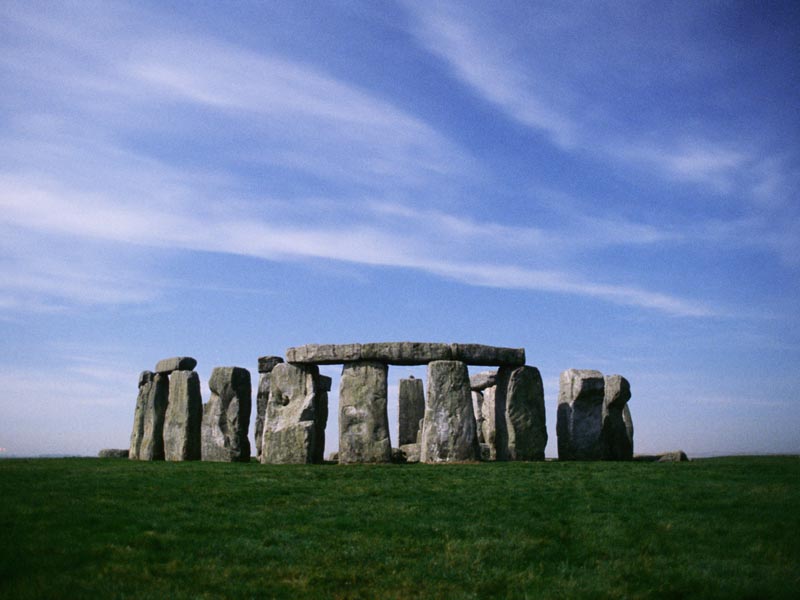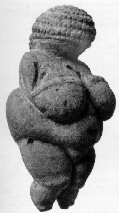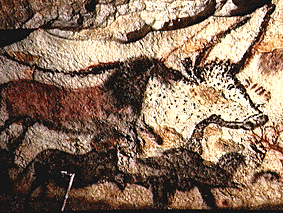Stone Age Synopsis:

Stonehenge Prehistoric human beings, the homo
sapien sapiens species to which we belong, evolved in Europe and the rest of
the world about 120,000 to100,000 years ago (Stokstad, 32). The earliest members
of this species resided in Africa and then spread to Europe and other continents.
The term prehistoric denotes the fact that there was no written language at
this time. There is no historical writings of this period, only the art and
architecture that survives today. Using these remains we are able to further
divide the prehistoric period, or Stone Age, into the following: the Paleolithic,
or Old Stone Age, consisting of the Lower, Middle, and Upper phases; the Mesolithic,
or Middle Stone Age; and the Neolithic, or New Stone Age. Conclusion
Without the written word it is very difficult to follow the developments of
prehistoric man. The art that remains from this period, however, gives us a
clearer picture of what life was life at this time and the changes that occurred.
Early sculpture reveals the tools available and the creative ability of prehistoric
man. Cave paintings portray developments in animal husbandry and farming techniques.
Architecture reveals the transition from a nomadic to a domesticated lifestyle.
Prehistoric art is therefore valued not only for its aesthetic qualities, but
as a key to early human cultures.
(Material) Source: Stokstad, Marilyn. Art: A Brief History. New York: Harry
N. Abrams, 2000.
Source: http://www2.students.sbc.edu/hill00/seniorseminar/summary1.html
Stone Age
Paleolithic Old Stone Age c. 30,000 - 9,000 B.C.
(Lower, Middle, and Upper)
Mesolithic Middle Stone Age c. 9,000 - 8,000 B.C.
Neolithic New Stone Age c. 8,000 - 1,500 B.C.
TERMS
Circa (ca.)
BC / BCE
Fetish - object believed to possess magical powers
Relief - carving or sculpture
Ocher - mineral pigment
Megalith
Lintel
Spirit Trap - form or vessel to house departed spirit,
so the spirit doesn't roam
Contour - outline and bulk of solid
Incise
Free Standing Sculpture
Obsidian - vitreous volcanic stone easily chipped into
fine cutting edges
Cromlech - circular arrangement of megaliths
Trilithon - tripartite stone structure (two vertical
stones capped by lintel)
Twisted perspective - representation of object showing
simultaneous views of object from different angles
SLIDES
Paleolithic

-
Venus of Willendorf, Limestone, Approx. 4-1/4” ca. 28,000-
25,000 B.C.
-
Woman Holding a Bison Horn, Painted Limestone, Laussel, 1’6”
ca. 25,000 - 20,000 B.C.
-
Two Bison, Clay relief, Le Tu d’Audoubert, France, Approx.
2' ca. 15,000 - 10,000 B.C.
-
Bison with turned head, Reindeer horn, Approx. 4” ca. 12,000
B.C.
-
Bison, Altamira, Spain Approx. 8’ ca. 12,000- 11,000 B.C.
-
Spotted Horse, Pech-Merle, France, 11’ 2” ca. 22,000 B.C.
-
Lascaux, France: ca. 15,000- 13,000 B.C.
-
Hall of Bulls
-
Chinese Horse Approx. 48’
-
Rhinoceros, Bison and Man Approx. 38”
Mesolithic
-
Ritual Dance, Addaura, Sicily ca. 15,000 - 10,000 B.C.
Neolithic
-
Jericho, Jordan ca. 8,000 - 7,000 B.C.
-
Human Skull, Jericho, Jordan ca. 7,000 - 6,000 B.C.
-
Catal Huyuk, Turkey ca. 6,000 - 5,900 B.C.
-
Landscape, c. 6150 B.C.
-
Deer Hunt, c. 5750 B.C
-
Goddess Giving Birth, 6,500 - 5, 7000 B.C.
-
Stonehenge, England circle is 97’ in diameter
ca. 2,550-1,600 B.C.
DJB Quick Notes:
Paleolithic:
~Paleolithic peoples of Franco-Cantrabrian region:
Cro-Magnon
~climate - tundra
~predominate food source - reindeer
~naturalistic animal representations with suggestions of movement
Mesolithic:
~human figures more prevalent, with movement, tools,
and devices depicted, but in stylized fashion
~figures portrayed on rock walls and cliffs rather than deep in caves
Neolithic:
~architecture develops
~non-indigenous artifacts found, indicating trade
~villages develop with enclosing walls
~"plastered” human skull from Jericho - found separate from body
~"spirit trap” defined: form or vessel that houses the spirit to
prevent the spirit from wandering
~abstract ideas - formation of formal structured religions, related to settled
existence
~Catal Huyuk pronunciation: katul hoyook
DJB In-Depth Notes:
Unlike the Paleolithic artist, who tried to represent
the concept of fertility with an abstract figure, the Neolithic sculptor converts an abstract
concept (a godess) into a human figure
Links
PALEOLITHIC CAVE ART
http://iws.ccccd.edu/murray/humaweb/forums/cave.htm
-
Survival
These people were living on the edge of survival. They knew only the
rudiments of civilization. They made a living by finding wild plants to
eat and killing large animals with rocks and pointed sticks. Life was short.
The adult population would have had the ages of a typical community college
population. Most of the adults would have been in their late teens to mid-twenties.
Some old folks would have survived into their thirties. People in their
forties or fifties would be ancient sages, revered for their knowledge and
experience -- and perhaps even a bit feared. (Keep in mind, however, that
these "old folks," who might seem a bit young to us, would have
looked pretty much like what we expect "old" to look like; the
rigors and hardships of their lives would have aged them faster.)
-
Bronze Age
The Neolithic culture dominated northern Europe until around 2000 BCE, when
metals began to gain importance in the lives of prehistoric humans.
-
Conclusion
Prehistoric art is therefore valued not only for its aesthetic qualities,
but as a key to early human cultures.



